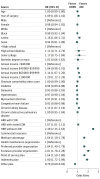Trends in Use of Ambulatory Surgery Centers for Cataract Surgery in the United States, 2001-2014
- PMID: 29167902
- PMCID: PMC5833604
- DOI: 10.1001/jamaophthalmol.2017.5101
Trends in Use of Ambulatory Surgery Centers for Cataract Surgery in the United States, 2001-2014
Abstract
Importance: Cataract surgery is commonly performed at ambulatory surgery centers (ASCs) and hospital outpatient departments (HOPDs). These venues differ in many ways, including surgical efficiency, patient throughput, patient safety, and costs per surgery.
Objective: To determine trends in use of ASCs and HOPDs for cataract surgery from 2001 to 2014 and factors affecting the site of surgery.
Design, setting, and participants: This retrospective longitudinal cohort analysis involved individuals 40 years and older who underwent cataract surgery between January 2001 and December 2014 from a nationwide US managed care network. Data were analyzed from February 2016 to February 2017.
Main outcomes and measures: We identified all enrollees who underwent cataract surgery and determined whether the surgery was performed at an ASC or HOPD. We calculated the proportion of surgeries performed at each site each year from 2001 to 2014. Multivariable logistic regression identified characteristics of enrollees who had cataract surgery at an ASC vs a HOPD. We also assessed geographic variation in the proportion of cataract surgeries performed at ASCs in 306 communities throughout the United States.
Results: Of the 369 320 enrollees included in this study, 208 319 (56.4%) were female, and the mean (SD) age was 66.3 (10.4) years. All enrollees underwent cataract surgery (531 325 surgeries) from 2001 to 2014. Of these, 237 046 (64.2%) underwent cataract surgery at an ASC. The proportion of cataract surgeries performed at ASCs increased from 43.6% in 2001 to 73.0% in 2014. Compared with enrollees with incomes less than $40 000, those with incomes greater than $100 000 were 20% more likely to undergo cataract surgery at an ASC (odds ratio, 1.20; 95% CI, 1.12-1.29). Enrollees with better overall health were no more likely to undergo cataract surgery at an ASC (odds ratio, 1.00; 95% CI, 0.99-1.00) than at an HOPD. Enrollees who lived in communities without certificate of need laws were more than twice as likely to have surgery at an ASC (odds ratio, 2.49; 95% CI, 2.35-2.63). The proportion of cataract surgeries performed at ASCs from 2012 to 2014 varied considerably, from 1.6% in La Crosse, Wisconsin, to 98.8% in Pueblo, Colorado.
Conclusions and relevance: We observed a large shift in the site of cataract surgery from HOPDs to ASCs from 2001 to 2014. Future research is needed to assess the effect of this transition in site of surgical care on patient access to surgery, surgical outcomes, patient safety, and societal costs.
Conflict of interest statement
Figures



Comment in
-
Ambulatory surgery centers vs general hospitals for cataract surgery in Europe.J Cataract Refract Surg. 2020 May;46(5):792. doi: 10.1097/j.jcrs.0000000000000120. J Cataract Refract Surg. 2020. PMID: 32358278 No abstract available.
References
-
- Cullen KA, Hall MJ, Golosinskiy A. Ambulatory surgery in the United States, 2006. Natl Health Stat Report. 2009;(11):1-25. - PubMed
-
- Koenig L, Doherty J, Dreyfus J, Xanthaopoulos J An analysis of recent growth of ambulatory surgical centers: final report. http://www.cascacolorado.com/wp-content/uploads/2009/06/KNG-Health-ASC-G.... Accessed May 8, 2017.
-
- Kadhim M, Gans I, Baldwin K, Flynn J, Ganley T. Do surgical times and efficiency differ between inpatient and ambulatory surgery centers that are both hospital owned? J Pediatr Orthop. 2016;36(4):423-428. - PubMed
-
- Shactman D. Specialty hospitals, ambulatory surgery centers, and general hospitals: charting a wise public policy course. Health Aff (Millwood). 2005;24(3):868-873. - PubMed
-
- Higgins A, Veselovskiy G, Schinkel J. National estimates of price variation by site of care. Am J Manag Care. 2016;22(3):e116-e121. - PubMed
Publication types
MeSH terms
Grants and funding
LinkOut - more resources
Full Text Sources
Other Literature Sources
Medical
Miscellaneous

